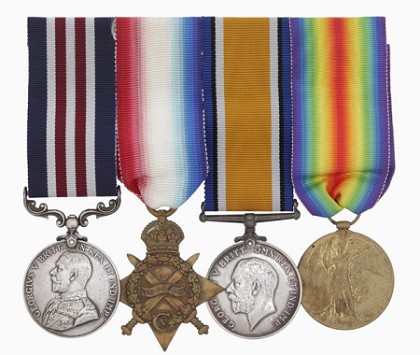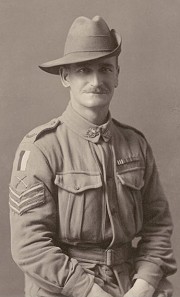Melbourne Tram Museum
- Follow Melbourne Tram Museum on Twitter
- Follow Melbourne Tram Museum on Facebook
- Follow Melbourne Tram Museum on Instagram
- Follow Melbourne Tram Museum on Pinterest
- Follow Melbourne Tram Museum on Tumblr
- Subscribe to Melbourne Tram Museum's RSS feed
- Email Melbourne Tram Museum
Tramway ANZAC: John Charles Aitken
Decorated Gallipoli stretcher bearer
John Charles Aitken was a gripman [1] with the Melbourne Tramway & Omnibus Company at Carlton Depot when he enlisted in the AIF on 18 August 1914. Born in Preston in 1882, he was married with four children and living in Abbotsford at the time of his enlistment.
He had fourteen years’ experience in the Australian militia, serving in the field artillery, infantry, and latterly the Army Medical Corps. This extensive military background resulted in his direct appointment as a sergeant in the 2nd Field Ambulance unit of the Australian Imperial Force (AIF).
His competence must have been immediately clear to his commanding officer, as he was promoted to staff sergeant only six weeks after joining up.
Field Ambulance units formed a key part of the military system to evacuate casualties in British and Commonwealth forces during the First World War. They were responsible for taking wounded from Regimental Aid Posts (RAP) just behind the front lines back to Casualty Clearing Stations (CCS). Minor wounds, injuries and illnesses were treated at either an RAP or CCS, while more serious cases were forwarded for further treatment to General Hospitals.
One of the conditions of soldiers' service in the Field Ambulance, and for that matter the Army Medical Corps in general, was that they were not permitted to carry arms of any kind.
Men of Field Ambulance units frequently acted as stretcher bearers in the front line, recovering men under sustained gunfire and artillery barrages. This was particularly common in the confined battlefields of the Gallipoli Peninsula, as well as the more open and mobile warfare of the Sinai and Palestine campaigns.
When Australian Field Ambulance units were transferred to the Western Front in 1916, the British system of military medicine was well established, so the more fluid arrangements used in other theatres of war were less common, except under times of great stress such as the German Spring Offensive of 1918, or the major British offensives of the Somme in 1916 and Passchendaele in 1917.
After landing in Egypt, along with the rest of the AIF, the 2nd Field Ambulance underwent extensive training, until they were embarked on transports for the Gallipoli campaign in April 1915.
Aitken landed in the first wave on the beaches of Anzac Cove, at 0500 on 25 April 1915. Some of the men of the unit remained on the transport ship, which was used to evacuate wounded back to the Greek island of Lemnos, and to Alexandria, Egypt.
Aitken’s bravery in recovering wounded under fire at Gallipoli was recognised by a mention in Divisional Orders on 13 July 1915.
In December 1915 the Allied forces were finally evacuated from the Gallipoli Peninsula. The 2nd Field Ambulance returned to Egypt with the rest of the AIF. Three months after the Gallipoli evacuation Aitken was promoted to Warrant Officer 1st Class, and immediately posted to the 1st Field Ambulance. In March and April, the Australian First and Second Divisions were transferred to France, to serve on the Western Front. The 1st Field Ambulance was part of this movement of troops, so Aitken arrived in France on 30 March 1916, at the Mediterranean port of Marseilles.
The Australians were quickly moved to quiet sectors of the front line, so they would have an opportunity to ‘toughen up’ and ‘raised to the same standards’ as veteran formations on the Western Front. British High Command viewed the colonial troops as raw and ill-disciplined, despite their experience at Gallipoli.
Trench warfare on the Western Front was very different in scale to that Aitken experienced on the Gallipoli Peninsula, as the concentration of artillery and machine guns was far greater than was employed at Anzac Cove. The Australians had also not yet experienced the new terror weapon – poison gas. It was not until July that they were committed to the offensive, firstly at Fromelles, and the following month at Pozières.
In a letter to his brother written on 16 August 1916, during the battle of Pozières – where the AIF suffered over 23,000 casualties – he described the stress of managing the men of the 1st Field Ambulance, keeping the flow of hundreds of casualties back from RAPs moving to CCSs where they could be taken to hospital, unless they died in the care of his unit.
In the most poignant section of the letter he wrote “...I don’t think I can stand the strain. My nerves are all run down after the sights I have seen lately…” It was clear that he was suffering from immense physical and emotional exhaustion.
On 27 October 1916, Aitken was decorated with the Military Medal, for his bravery under fire at Gallipoli. His medal citation reads:
For repeated acts of gallantry in bringing wounded men in under heavy rifle and shell fire during the period April 25th to June 28th 1915 at ANZAC.
In August 1917 Aitken was promoted to Lieutenant and transferred to the 7th Field Ambulance in Belgium, where he was appointed as the unit quartermaster. However, the stress of active service seriously affected his health. Suffering from shortness of breath, in June 1918 he was examined by a medical board at Rouelles, in north-eastern France. Aitken was overweight, and diagnosed with emphysema, chronic bronchitis, arthritic knees and a heart condition. The board found him unfit for active service.
He spent time convalescing in hospital in England, before returning to Australia in September 1918, having never carried a weapon into combat.
Lieutenant Aitken was finally discharged from the AIF on 2 December 1919, his health permanently damaged. He re-joined the tramways, eventually becoming a senior inspector. He and his wife also had another child.
John Charles Aitken died suddenly on 25 March 1933, aged 51. His early death was judged to be a result of his war service.
 Medals of Lieutenant J.C. Aitken. From left: Military Medal, 1914-15
Star, British War Medal 1914-20, Victory Medal.
Medals of Lieutenant J.C. Aitken. From left: Military Medal, 1914-15
Star, British War Medal 1914-20, Victory Medal.- Photograph courtesy of the Australian War Memorial.
Acknowledgements
Many thanks to the Sheehan family – descendants of John Charles Aitken.
Bibliography
Australian War Memorial (2015) Military Medal : Staff Sergeant J C Aitken, 1 Field Ambulance, AIF
Discovering Anzacs (2014) Don’t Think I Can Stand The Strain, 16 August 2014
National Archives of Australia (1914-1918) John Charles Aitken – Service Record
The Argus (1933) Deaths, 27 March 1933
Footnote
[1] Gripman was the standard title used in Melbourne for a cable tram driver.
